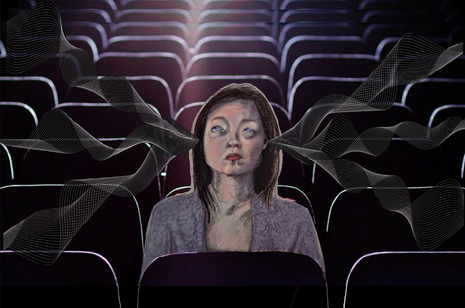How films ‘hack’ your senses
Kalina Poydovska explores how perceptual illusions are used to manipulate your movie experience

Film fundamentally relies on illusion. Videos are essentially sequences of overlapping still images, or ‘frames’. When these frames are shown in quick succession – typically 24 per second – our brains interpret them as smooth motion. This illusion is known as the phi phenomenon. Moreover, when motion (such as moving mouths) is paired with sounds emanating from speakers (such as speech), we instinctively infer that the latter is being caused by the former, that people are speaking. This may seem obvious at first glance, but it is a remarkable perceptual feat.
By tapping into our mechanisms of perception in even subtler ways, a new reality can be created. Filmmakers have a variety of tricks in their arsenal to make us feel and experience things that are not there.
“By tapping into our mechanisms of perception, a new reality can be created”
The Shepard tone illusion is favoured by Christopher Nolan (of Interstellar, Oppenheimer, Inception). This illusion deceives the ears into hearing an infinitely rising scale, evoking a sense of infinitely rising tension. To conjure the illusion, the same note is played in several octaves (often three) at once. Starting from this note, an ascending scale is played, again across the three octaves in tandem. The loudness of these three layers is continually adjusted as the scale progresses: the middle pitch must always remain audible, with the lower gradually growing louder, and the upper gradually quieter. It sounds as though the upper scale is constantly fading out and the lower scale is constantly fading in. The sound seems to rise continuously even though the scale is, in fact, looping back around.
The illusion occurs because our brains often make assumptions in the face of sensory ambiguity. We can distinguish what the notes in the scale are, such as C followed by C sharp (known as pitch class), but not what octaves they are in (known as pitch height), because the notes are being played in all three octaves at once. The brain fills in the blanks: based on the fact that pitch class is rising, we may make the inductive leap that pitch height is also rising. And since these scales have no distinct starts or stops, flowing into one another, a sense of continuity is created. This is why the Shepard tone illusion is also known as the ‘barber pole illusion’. Much like the red and white stripes of a barber pole, the sound seems to ascend endlessly without actually going anywhere.
“The illusion occurs because our brains often make assumptions in the face of sensory ambiguity”
A Shepard tone is used to give the effect of the Batpod zooming away in The Dark Knight trilogy, whilst Warzone stakes and magician rivalries are evoked in Dunkirk and The Prestige. This illusion elicits a range of emotional responses in different people. Many report an unsettling ‘equilibrium disturbance’: the brain expects some sort of resolving pitch, but never gets one. Interestingly, others experience more positive feelings. Individual effects may vary based on personality traits like neuroticism (anxiety sensitivity).
Horror movies are especially adept at utilising sound to create a sense of creepiness and unease. Humans rely on a range of mechanisms to locate where sounds come from, and movies like A Quiet Place expertly take advantage of these. The premise of the film is that any tiny sound is sufficient to catch the attention of the ‘big bad’: the slightest whisper or the snapping of a twig may bring death. To make the audience feel this tension on a deeper level, a technique known as binaural audio recording was used. The film’s sound editors describe how recordings were made using a special microphone (the Neumann KU 100), which was shaped like a human head and ears. The microphone effectively ‘heard’ sound in the same way a real person would, and noises were filtered by the ‘head’ and ‘ears’ just as if you were physically standing there.
Indeed, our bodies have a strong influence over how we receive and interpret sounds. We can determine the direction from which sounds originate by comparing the signals that reach our two ears. If a sound comes from the left, it will be heard first (and likely louder) in the left ear. These cues, known as interaural time and interaural intensity differences, help us to identify the sound as coming from our left- or right-hand side. Sound waves coming from different angles also get distorted by the head and outer ears in different ways. Binaural audio mimics such sound cues, allowing for a greater degree of immersion. This technique allows us to step into the sensory world onscreen. It is especially crucial in scenes where the characters are listening through headphones or hearing sounds emitted by their own hearing aids.
We’ve all experienced how certain sound effects instill dread, while others elicit warm fuzzy feelings. This movie magic can be broken down to a science, and our senses manipulated to influence the impression we’re left with after watching a film.
 Features / Should I stay or should I go? Cambridge students and alumni reflect on how their memories stay with them15 December 2025
Features / Should I stay or should I go? Cambridge students and alumni reflect on how their memories stay with them15 December 2025 News / Cambridge study finds students learn better with notes than AI13 December 2025
News / Cambridge study finds students learn better with notes than AI13 December 2025 News / Dons warn PM about Vet School closure16 December 2025
News / Dons warn PM about Vet School closure16 December 2025 Comment / The magic of an eight-week term15 December 2025
Comment / The magic of an eight-week term15 December 2025 News / News In Brief: Michaelmas marriages, monogamous mammals, and messaging manipulation15 December 2025
News / News In Brief: Michaelmas marriages, monogamous mammals, and messaging manipulation15 December 2025









